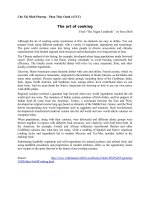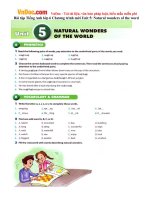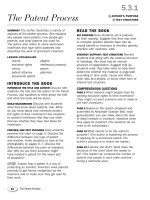5 3 5 the art of makeup going behind the mask
Bạn đang xem bản rút gọn của tài liệu. Xem và tải ngay bản đầy đủ của tài liệu tại đây (3.66 MB, 12 trang )
Suggested levels for Guided Reading, DRA,™
Lexile,® and Reading Recovery™ are provided
in the Pearson Scott Foresman Leveling Guide.
THE ART OF MAKEUP
Going Behind the Mask
Genre
Expository
nonfiction
Comprehension
Skills and Strategy
• Graphic Sources
• Main Idea and
Details
• Prior Knowledge
Text Features
• Table of Contents
• Captions
• Glossary
Scott Foresman Reading Street 5.3.5
ISBN 0-328-13544-5
ì<(sk$m)=bdfe i< +^-Ä-U-Ä-U
by Kathleen Cox
Reader Response
1. How did the photographs and captions on pages
12–15 help you understand the process of making
false teeth for movies?
2. Before you read this book, what did you know about
makeup artists? What did you learn about them while
reading this book? What would you still like to learn
about them? Use a graphic organizer like the one
below to write your answer.
What I
Know
What I
Want to Know
THE ART OF MAKEUP
Going Behind the Mask
by Kathleen Cox
3. Thinking about movies you’ve seen, explain why the
background or landscape in a scene is important.
4. Why is a skilled makeup artist needed for creating
three-dimensional makeup?
Editorial Offices: Glenview, Illinois • Parsippany, New Jersey • New York, New York
Sales Offices: Needham, Massachusetts • Duluth, Georgia • Glenview, Illinois
Coppell, Texas • Ontario, California • Mesa, Arizona
CONTENTS
INTRODUCTION
4
The Magic of Makeup
CHAPTER ONE
7
Three-Dimensional Makeup
CHAPTER TWO
12
Making False Teeth
CHAPTER THREE
16
Making Wigs
Every effort has been made to secure permission and provide appropriate credit for
photographic material. The publisher deeply regrets any omission and pledges to
correct errors called to its attention in subsequent editions.
Unless otherwise acknowledged, all photographs are the property of Scott Foresman,
a division of Pearson Education.
CONCLUSION
18
Makeup and Special Effects
Glossary
20
Photo locators denoted as follows: Top (T), Center (C), Bottom (B), Left (L), Right (R),
Background (Bkgd)
Opener: Corbis; 1 Corbis; 4 Brand X Pictures; 5 Corbis; 6 Corbis, Alamy Images, Visionary
Media; 7 Corbis, Brand X Picture; 8 Visionary Media, Brand X Pictures; 9 Visionary
Media; 10 Corbis; 11 Brand X Pictures; 12 Prosthetic, Brand X Pictures; 13 Prosthetic;
14 Prosthetic; 15 Prosthetic, Brand X Pictures; 16 Visionary Media, Corbis, Brand X
Pictures; 17 Alamy Images, The Granger Collection; 18 20th Century Fox/The Kobal
Collection; 19 Corbis, Brand X Pictures
ISBN: 0-328-13544-5
Copyright © Pearson Education, Inc.
All Rights Reserved. Printed in the United States of America. This publication is
protected by Copyright, and permission should be obtained from the publisher
prior to any prohibited reproduction, storage in a retrieval system, or transmission
in any form by any means, electronic, mechanical, photocopying, recording, or
likewise. For information regarding permission(s), write to: Permissions Department,
Scott Foresman, 1900 East Lake Avenue, Glenview, Illinois 60025.
2 3 4 5 6 7 8 9 10 V0G1 14 13 12 11 10 09 08 07 06 05
3
Introduction
The Magic of Makeup
Think back to the movies you’ve seen recently. How
many of them had actors wearing makeup? Chances are it
was every single one. It would be practically impossible to
make movies without using makeup!
Makeup is one of the most important special effects
used in movies. But we take it for granted because we
don’t see the work that goes into creating it. If an actor is
playing a role from everyday life, then his makeup might
take only thirty minutes to apply. But if he’s playing an
unusual role, such as a prehistoric ape in a sciencefiction film, then his makeup can take hours. Even the
actors standing in the background looking like part of
the landscape of a science-fiction movie can require
hours of makeup work.
Makeup artists have to be perfectionists. It takes hours
for them to apply an actor’s makeup because they have to
get every detail right. They also work with substances that
have to dry or set in a certain way. If the substances are
mixed wrong, the mask will crack or break. It’s not easy
being a makeup artist!
The masks worn in Hollywood
movies can take hours to make.
4
5
There are other reasons why makeup takes so long.
One of the biggest is that makeup artists are responsible
for an actor’s safety. For example, masks can cause
breathing problems. So makeup artists have to ask actors
if they are having trouble breathing. If they are, the artists
must find a solution to the problem. Makeup artists also
work with harmful substances. So they take lots of time
making sure they mix things correctly.
If it sounds as if being a makeup artist is hard, you’re
right! But it can also be very rewarding. The following
pages describe how the men and women that do makeup
for movies create three-dimensional makeup, wigs, and
false teeth. Keep reading to find out about a world that is
usually only experienced by actors and makeup artists!
An actor wearing early three-dimensional makeup
Chapter One
Makeup artists do lots of things, from making fake
skin and false teeth to preparing an actor’s fake hair.
6
Three-Dimensional Makeup
The phrase three-dimensional makeup sounds fancy,
but all it means is makeup that involves a mask. Threedimensional makeup, unlike lipstick and eyeshadow, can’t
be painted on. It is made through a complicated, timeconsuming process. But the results are worth it!
The most advanced three-dimensional makeup is the
kind used to make foam latex masks. These masks are
now used frequently in Hollywood movies.
There is no one correct way to make foam latex masks.
Makeup artists make them in different ways based on
what they like and what’s available to them. The following
pages describe just one way to make a foam latex mask.
7
Next the artist pours plaster into the mold. The plaster
hardens into a cast of the actor’s face. Do you understand
the difference between a mold and a cast? A mold is a
form that gives shape to things. A cast is the shape created
by the mold.
Now the makeup artist covers the cast with a layer of
clay. He shapes the surface of the clay to match the sketch
of the finished mask. Then he puts the cast with the clay
model of the mask faceup on a table. Cardboard walls are
put up around the clay model. This creates a new mold.
Actors wear protective coverings in case the makeup drips.
These makeup artists have just started work on a mask. They
have left the actor’s nose uncovered so he can breathe safely.
Foam Latex Masks
Makeup artists can’t start a foam latex mask without
knowing what the finished mask will look like. So they
start by drawing a sketch of the mask. The sketch reminds
the artist of what they want the final mask to look like.
Next the artist gets together with the actor. He covers
the actor’s face in alginate. Alginate is a rubber-like
substance used by dentists to make molds for teeth.
The alginate recreates the shape of the actor’s eyes,
ears, nose, and other features. Once the alginate hardens
the artist removes it. The hardened alginate creates a
mold.
8
9
1
Next the makeup artist pours plaster over the clay
model of the mask. The cardboard walls keep the plaster
in place around the mask model. When the plaster
hardens, the artist removes it from the model. This plaster
cast becomes the mold for the final mask.
Finally the makeup artist pours latex foam into the cast
of the mask. Then he presses the cast of the actor’s face
into the foam. These two casts combined create the final
mold for the mask. The outside of the finished mask will
look like the mask model. The inside of the mask will fit
the actor’s face perfectly.
The artist ties this mold and foam “sandwich” together
and heats it in an oven. When the latex foam has cooled,
the artist removes the mold of the actor’s face and peels
the finished mask away from the mold of the mask. The
artist checks it to make sure the latex has no bubbles or
tears. Then the artist can add the finishing touches, such
as color and hair.
1. A makeup artist is applying regular
makeup to a finished mask.
2
10
2. The regular makeup blends the
mask’s edges into the actor’s
skin.
11
Chapter Two
Making False Teeth
The process used to make false teeth is different from
the process used to create foam latex masks. But in both
cases artists start with the same substance: alginate.
First the makeup artist pours alginate into a dental tray.
He or she inserts the tray into the actor’s mouth. After
about a minute, the artist removes the tray from the actor’s
mouth. The paste hardens into a dental impression like
the one shown on page 13. A dental impression is a mold.
So far the process resembles what dentists do when
they make dental impressions to repair or straighten teeth.
Getting false teeth made can resemble a trip to the dentist.
12
In the next phase, the artist mixes water with some
plaster. The mixture forms a thin paste. The artist pours
the paste into the dental impression mold.
While the paste hardens, the artist adds more plaster
on top of the first layer. The second coat of plaster mixes
with the first coat and creates a cast. When the cast dries,
the makeup artist removes it from the dental impression.
Now the artist uses some plaster to build a base for the
cast. He attaches the cast to the base. Next he covers the
cast of the teeth with clay. He shapes the clay to match
the false teeth required by the actor’s role. Then the artist
plunges the clay-covered cast into a bowl filled with either
alginate or plaster. This creates a second mold.
A finished dental impression, attached to the dental tray
13
Now the artist mixes a special substance used to make
false teeth. They pour the substance into the new mold.
Remember the cast from earlier? Now the artist presses
it into the mold, on top of the special substance. This
creates a “sandwich” like the one that was made for the
foam latex mask. This sandwich consists of the plaster
cast of the actor’s teeth and the second mold, with the
special substance in between.
The artist binds the sandwich, just like the foam latex
sandwich was bound. The binding causes the special
substance to harden into false teeth. On the inside, the
false teeth match the actor’s real teeth. But on the outside,
they look like the teeth required for the actor’s role.
Making false teeth requires lots of time and patience.
14
When the false teeth have hardened, the artist
separates the mold from the cast. He carefully removes
the false teeth that are inside. Next, the artist files the false
teeth to sharpen them. He might dunk them in coffee if
the actor’s role requires that they be stained.
Finally, the actor tries on the false teeth. The false teeth
must fit perfectly. Otherwise they will damage the actor’s
real teeth. The artist adjusts the false teeth until the actor
says they are comfortable. And that’s it!
False teeth and foam latex masks are made with similar
materials. These materials can be harmful. Only trained
adults should make foam latex masks and false teeth!
Today’s makeup artists can create false
teeth that are incredibly lifelike!
15
Makeup artists use several
different tools and methods
to create wigs.
Next the artist lays a piece of lace over the wooden
model. He cuts the lace to match the tracing he made of
the actor’s hairline. This creates a foundation for the wig.
The last step is the longest one. The makeup artist
has to sew actual human hair onto the foundation. This
step, called ventilating, is very complicated and timeconsuming. Thousands of individual hairs have to be
sewed onto the foundation to make the wig look lifelike.
But once the ventilating is done, the wig is complete!
Unlike the materials used to make foam latex masks
and false teeth, the materials used to make wigs are
completely safe. As long as a trained adult is providing
guidance, it is OK for students to make wigs.
Chapter Three
Making Wigs
Wigs are different from foam latex masks and false
teeth. Makeup artists do not make molds or casts to create
wigs. Nor do they use substances like plaster or alginate.
In certain ways wigs are easier to make than foam latex
masks and false teeth. But they are by no means simple.
A makeup artist starts a wig by taking measurements of
the actor’s head. He uses those measurements to create a
rounded wooden model in the shape of the actor’s head.
Then the artist transfers the outline of the actor’s
hairline to the wooden model. He starts by pressing pieces
of paper against the actor’s head. Next he uses a pen to
trace the actor’s hairline onto the pieces of paper. Then
the artist uses scissors to cut the pieces of paper along the
tracing.
16
Wigs became very popular
in Europe during the
seventeenth century.
17
Conclusion
Makeup and Special Effects
When people talk about a Hollywood movie these days,
they often focus on its special effects. The phrase special
effects refers to the pictures and sound effects that are
added to a movie after it has been shot.
Since the late 1970s, filmmakers have been using
computers to create amazing special effects. Computers
can make an actor of normal height look like a miniature
human being. They can have an image reassembled
in a way that is impossible in the real world. Modern
computers give directors the ability to create just about
any kind of special effect that you can imagine!
Modern special effects are impressive. But many of
them wouldn’t make sense if they weren’t combined
with the makeup worn by Hollywood actors. Foam latex
masks, false teeth, and wigs are often just as important as
a movie’s special effects. Like special effects, these items
help convince audiences that fantasy is actually reality.
In some movies, the makeup is so extreme—for
example, transforming a human into an ape—that the
importance of the makeup is obvious. In other films, the
makeup may be so natural that you don’t notice it at
all. But no matter what the movie, makeup is essential.
Makeup helps create movie magic!
Today’s makeup artists can transform a
human actor into a fantastic creature.
18
19
Glossary
Reader Response
background n. the part of
a picture or scene toward
the back.
prehistoric adj. of or
belonging to times before
histories were written.
1. How did the photographs and captions on pages
12–15 help you understand the process of making
false teeth for movies?
landscape n. view of
scenery on land.
reassembled v. brought
together again.
2. Before you read this book, what did you know about
makeup artists? What did you learn about them while
reading this book? What would you still like to learn
about them? Use a graphic organizer like the one
below to write your answer.
miniature adj. done or
made on a very small
scale; tiny.
What I
Know
What I
Want to Know
3. Thinking about movies you’ve seen, explain why the
background or landscape in a scene is important.
4. Why is a skilled makeup artist needed for creating
three-dimensional makeup?
20









